|
|
|
|
|
“DO THEY BOTH GO ROUND,
MISTER?” |
|
Scale-model designer Dave
Milbourn offers some insights into the various methods used for
controlling twin propellers. |
|

Dave's Definitive answer
for setting up Twin Electric Motor installations! |
There is no doubt that the
single-screw R/C model boat is the simplest form of the powered genre.
Quite apart from the added complications of building a multi-screw boat,
the modeller needs only to purchase, fit and maintain one of everything
e.g. motor, shaft, coupling, speed controller etc. If building an exact
replica of a twin-engined boat isn’t for you there’s no reason why you
shouldn’t adapt the model below the waterline to use a single prop
instead. Glynn Guest’s simple balsa-and-card models of warships are one of
the best examples of this approach to design, and their popularity
demonstrates that not everyone wants or needs to build more complex
models. This philosophy doesn’t stop there; I wonder how many modellers
have built a Huntsman or Perkasa without realising that the full-size
craft had respectively two and three props. |
If you balk at the idea of not having two props on a scale model of a
twin-prop boat then one approach is to fit a single motor which is geared
to two shafts/props. For a “performance” model this would have some
advantages, as geared drives are usually more efficient than direct
drives. One might alternatively fit two motors connected to the same speed
controller, although some care would be required to ensure that the motors
were evenly matched. For slower scale models, however, the use of two
independently controlled motors can greatly enhance manoeuvrability by
taking advantage of asymmetric thrust. Let’s consider first of all the
mechanics of how a boat turns. |
|
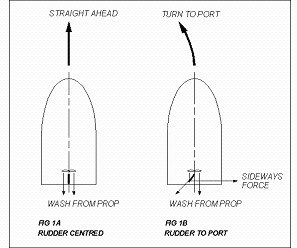
|
In Fig 1A, the rudder is centred and the propeller is pushing the water
straight back over it. The only thrust force acting on the model is in
line with its direction of travel so the boat will move straight ahead.
Fig 1B shows the rudder turned to port. Some of the wash from the prop is
now deflected “off course”, producing a sideways force on the rudder. We
now have two thrust forces acting on the model; one pushing it forward and
another tending to push the stern towards the starboard side. The result
is that the forward speed will drop very slightly and the boat will turn
to port. Quite how much the boat turns depends on the amount that the
rudder is deflected and the speed of the prop-wash over it. OK – so it
also depends on the size of the rudder but you’re not about to dive into
the water with a hacksaw and file to change that, are you? Dead
simple so far, so let’s double the number of rudders and props. |
|
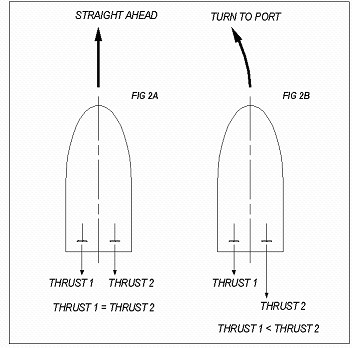
|
|
Fig 2A shows our twin-screw
model at full-ahead – assume the rudders are centred. So far it looks just
like Fig 1A but things are not as simple as they seem. The props are no
longer on the centre-line of the model so any thrust they produce will
also have a turning effect (or “moment”) about the boat’s vertical axis.
It’s only when the props are producing the same amount of thrust that
these turning forces are balanced out, and the model will travel straight
ahead. If you slow down one of the props (Fig 2B) the net effect will be
to turn the boat slowly towards the slower prop. If that sounds clumsy
then think of a rowing boat; if you pull harder on one of the oars then
the boat will turn away from that oar. It should be noted that these
forces are in play regardless of the position of the rudders. |
As I mentioned earlier, the rudders have a decreasing effect on the rate
of turn as the speed of the water flowing over them is reduced. This
explains why boats don’t steer as well when going astern, because the wash
from the props is moving away from the rudders instead of over them. Those
who can remember the first time they tried docking a model in a steering
competition will know how embarrassing this can be! The beginners’
technique seems to be to slam the rudder hard-over, stab the throttle and
pray you’ve got them both in the right direction. If you can harness the
asymmetric thrust effect from twin props then the rudders become almost
irrelevant for slow-speed manouvering. On full-size vessels this is
usually done by having the two throttles side-by-side on the same
binnacle. They can then be moved together for altering the speed of the
boat, or “split” for the sort of effect described above. We are not,
however, dealing with the big ‘uns here. |
|
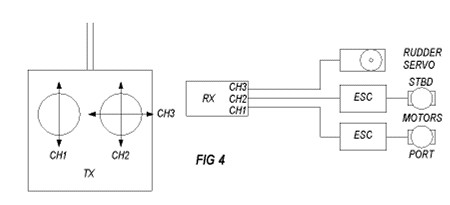
|
|
Fig 4 shows the R/C equivalent
of the controls available to a full-size vessel’s skipper. The LH stick
controls the electronic speed controller (ESC) for the port motor while
the RH stick controls the starboard one. Incidentally, it is usual for
twin props to be set-up as per Fig 3, with the starboard prop rotating
clockwise and the port anticlockwise when viewed from the rear. It is also
convention – at least among right-handed skippers – to use the lateral
movement of the RH stick to control the rudders. Many modellers replace
the ratchet on the LH stick with a self-centring spring, so that both
sticks return to neutral in both planes when you release them. Usually a
call to the distributor of your R/C gear will elicit the few components
necessary to do the job – often for little more than the cost of postage
(thanks, Amerang!) You will now have direct and fully independent control
over both motors, as well as being able to apply any amount of rudder
control desired. This independent control of the motors is often referred
to as “tank steering” because it mirrors the way a tank-driver controls
the tracks of his vehicle to steer it. It does have two drawbacks; you
will have spotted that it requires a 4 or 6 channel transmitter i.e. one
with two dual-axis sticks, and it demands an awful lot of practice and
concentration to make the model do what you want it to. If you’re the sort
of person who can pat the top of your head with one hand while rubbing
your tummy at the same time with the other, then tank-steering is probably
the ultimate in controlling your model boat. What about the rest of us,
though? |
|
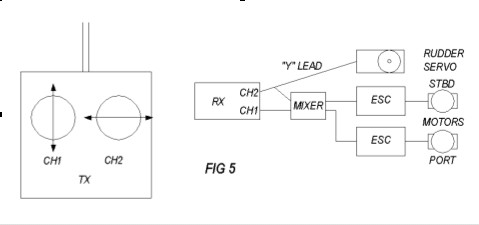
|
|
Fig 5 shows the installation
of a typical mixer unit. This is an electronic device which is fitted on
board the model and is connected to both the rudder and throttle outputs
from the receiver. It draws its power from the receiver pack and is
typically no larger than a receiver. Quite how it works is a mystery to me
– something to do with a microprocessor, I gather – but it senses signals
from both the throttle and steering outputs and automatically slows down
the motor on the inside of the turn dictated by the steering command.
There are two types of mixer available. One will go as far only as
stopping the inboard motor at “full rudder” (a 50% mix) whereas the other
will actually put the inboard motor into full reverse (100%). This latter
enables a model to spin round in its own length. In practical terms a
long, thin model such as a warship or submarine would be best suited by a
50% mixer, whereas tugs and other workboats would probably be better off
with the Full Monty job. Beware of earlier units, however. Some of them
actually worked against the rudder command when going astern so do
check before you part with any money. |
|
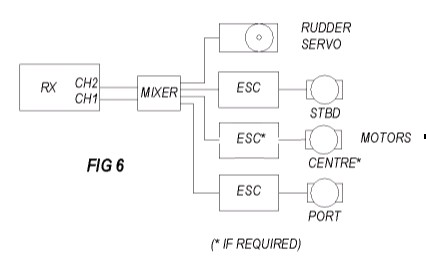
|
The ACTion Marine Mixer which I personally favour works correctly in both
forward and reverse, and it has a couple of useful features which you
might wish to note (See Fig 6). There is no need to buy and fit a Y-lead
here, as the mixer has a “straight-through” connection which enables you
to plug the rudder servo into the mixer itself. It also has a
straight-through (unmixed) output for use where a model has a third motor
installed along the keel-line and which doesn’t require mixing e.g. a
model warship. Contrary to popular mythology, you don’t need a university
degree to set up a mixer in your model. I have used both the Hunter
Systems and ACTion units and found that both worked fine if you follow
the detailed instructions closely, in the order given. It is useful if
you have a couple of spare servos to assist in the initial setting-up
procedure on the bench before the mixer is fitted into the model. It may
seem rather obvious but you should ensure that you use speed controllers
of the same type and current-rating and take care that the motors are as
near to identical in performance as you can reasonably find. This advice
applies equally to models fitted with “tank steering”. In respect of power
supplies, I have used separate packs for each motor/ESC in some models and
run both motors from the same battery in others. The latter seems to make
more sense as it side-steps the risk of one pack running down faster than
the other and mucking up your steering that way. The only slight
problem I have ever found was when one motor seemed to run up to
full-speed quicker than the other on the bench. By the time the model was
in the water, however, it was impossible to notice any effect on the
handling. |
Mixers have two main
advantages over tank-steering; there is no need to buy a 4 or 6 channel
radio to enjoy the benefits of controlling twin motors, and they do take
the pain out of stirring the sticks. As my friend Lawrie White says,
however, they will always mix the rudder and throttle commands
together irrespective of whether or not it is actually the most
appropriate command for the situation. You simply have to get to know how
your model responds to given commands. I understand that many modern
computer radios include the facility to program in a “mix” between any two
channels and also to adjust the amount of mix applied (e.g. 0% - 100%). I
don’t have one of these sets so I can’t advise you any further about them
– save to say that they are much more expensive than the
non-computer types, whereas an on-board mixer unit will cost you only
around £30 - £40, built and tested if you require it. |
So the BIG QUESTION is “which is best for my particular model?” I don’t
personally think that the model matters half as much as the
builder/skipper. I suspect those who have mastered the black art of
tank-steering would never dream of using a mixer, while those whose thumbs
don’t work like that are probably better off with one. I count myself
firmly in the latter group!!
(Article first published in
Model Boats magazine)
Many thanks to Dave Milbourn for digging this out for me and 'OCR ing' it
etc. - Martin, Mayhem
|
|
Back to Electrical Index
HOME |